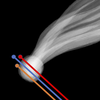|
Comet Interceptor also has an ESA website
By exploring comets, we learn about the origins of our Solar System.
All comets that have been encountered by spacecraft so far are short-period comets: objects that have approached the Sun many times, and have thus undergone changes on their surfaces, erasing their original appearance and make-up. A true, pristine comet has yet to be encountered and explored. Such objects are difficult to target because they can only be discovered when approaching the Sun for the first time, leaving little time to plan and launch a mission to them. Advances in technology are now making such a mission possible. A new generation of powerful survey telescopes, including the upcoming Large Synoptic Survey Telescope, LSST, are discovering comets far enough away as they approach the Sun that they can be targeted by space missions. The Comet Interceptor mission was selected by ESA in June 2019 to combine this breakthrough in comet discoveries with a compact, agile set of spacecraft that can reveal to us a huge amount about a long period comet, ideally one is truly pristine, entering the inner Solar System for the first time. Although far rarer than long-period comets, Comet Interceptor will also have the capability of encountering an interstellar object passing through our Solar System if such an object is found on a suitable trajectory. The mission proposal was submitted to the European Space Agency in March 2019 in response to ESA's call for F (Fast)-class missions, and is now undergoing development by the agency, in cooperation with the Japanese Space Agency JAXA, for launch in 2029. |
